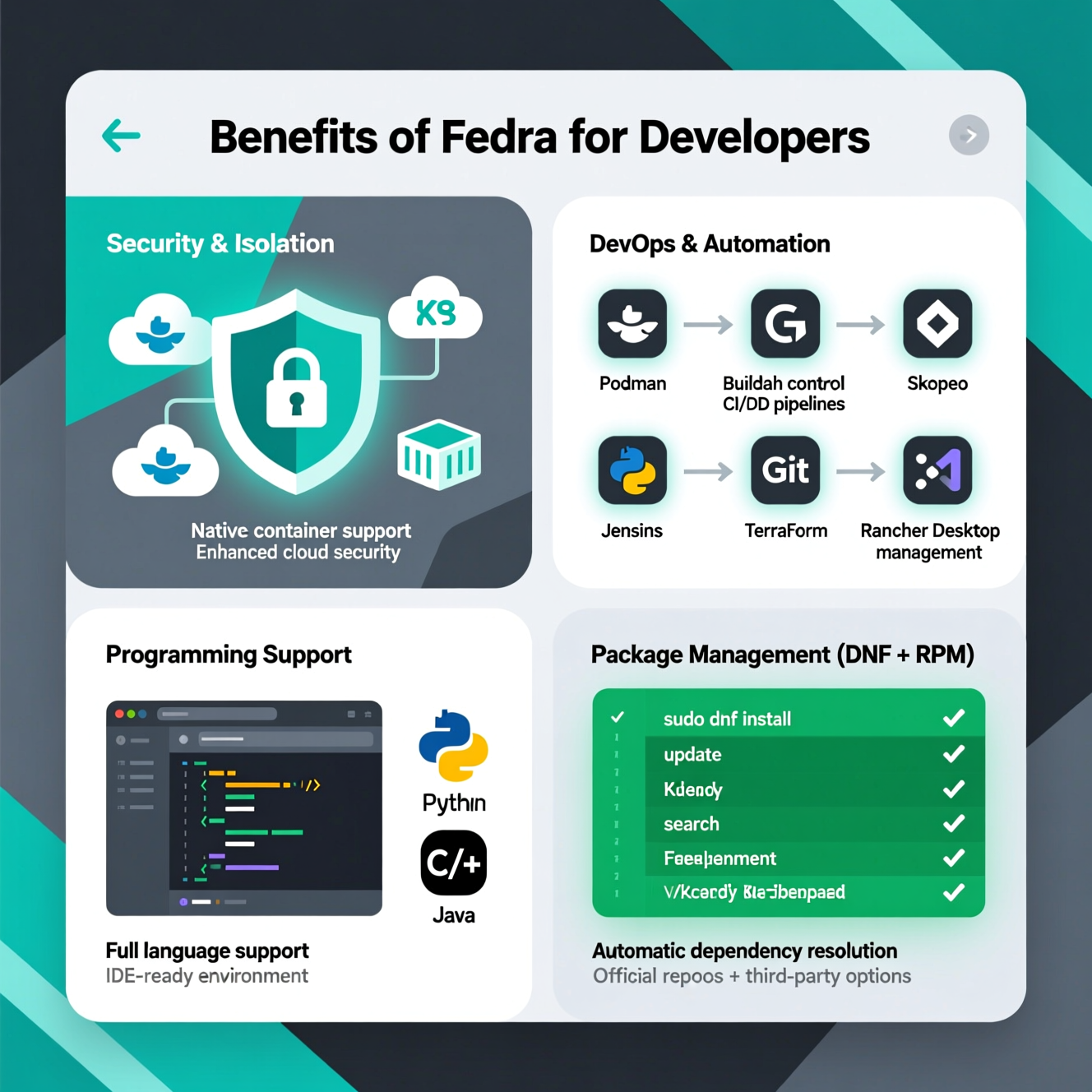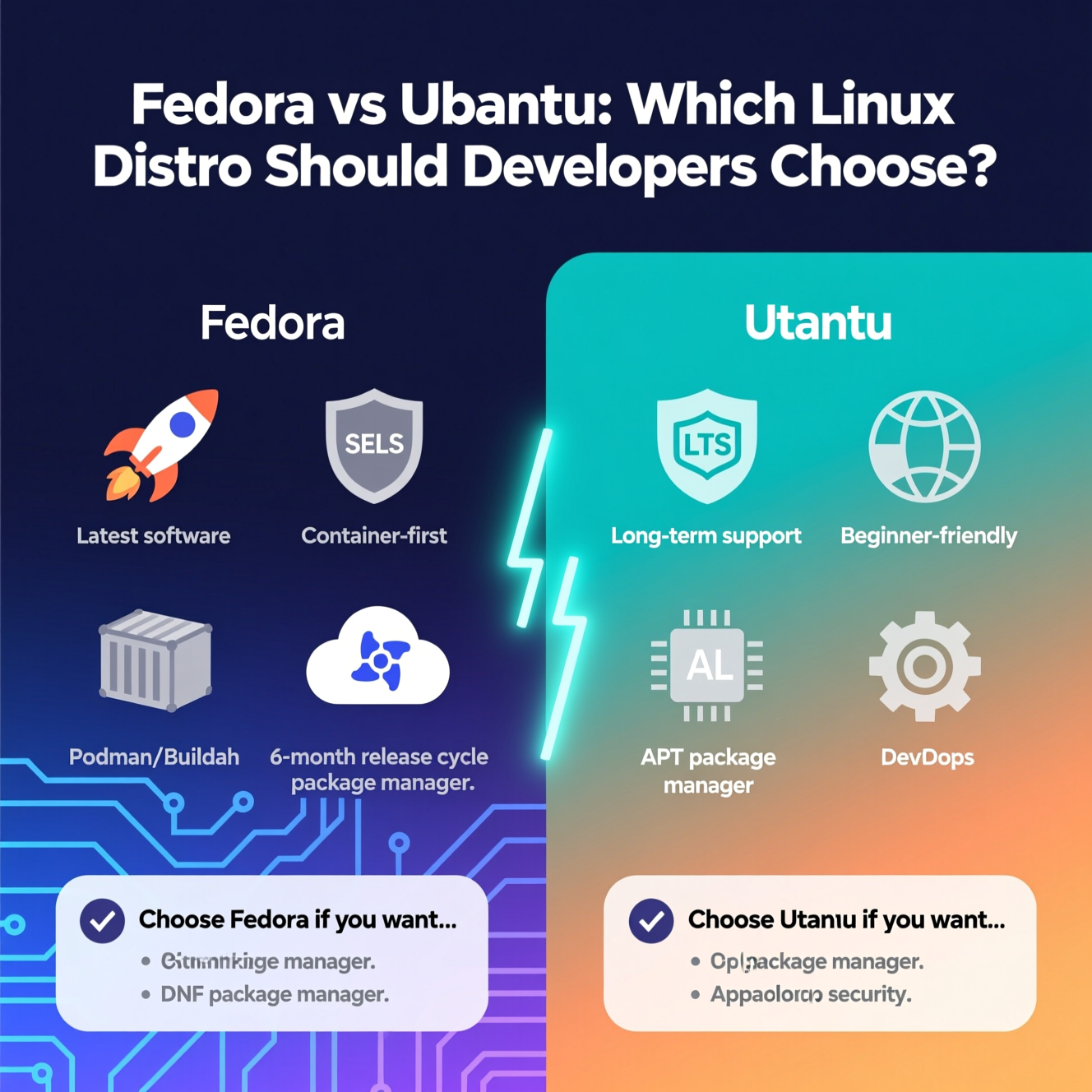In the world of software development, choosing the right operating system can significantly impact productivity and security. Fedora Workstation is one of the best Linux distributions for developers, offering high performance, advanced security, and cutting-edge development tools. Whether you are a developer seeking a modern environment to experiment with the latest technologies or a DevOps team looking for full container and automation support, Fedora provides a flexible and powerful platform to get your projects done efficiently. In this blog, we will explore everything you need to know about Fedora Workstation—from SELinux security, DevOps and development tools, package management, to setting up a VPS with EgyVPS—along with a quick comparison with Ubuntu to help you decide which distro suits your needs.

Linux is a top choice for developers worldwide because of its high performance, flexibility, and powerful command-line interface. Fedora stands out as a modern, cutting-edge Linux distribution, providing developers with:
Performance: Fedora runs efficiently with minimal system resources.
Control: Full control over the system, ideal for customizing a development environment.
Rapid Updates: Frequent releases (~every 6 months) with the latest compilers, languages, and libraries.
DevOps Friendly: Built-in support for containers, CI/CD pipelines, and automation tools.
Other popular Linux distributions for developers include:
Ubuntu: User-friendly and stable, ideal for beginners.
Debian: Highly stable and reliable.
Arch/Manjaro: Fully customizable with advanced control.
GNOME by default: clean, productive, and modern.
Optional desktops: KDE Plasma (full customization), Xfce (lightweight), LXQt (minimal resource usage).
SELinux (Security-Enhanced Linux) adds a powerful security layer:
Prevents unauthorized actions, even with root privileges.
Uses Mandatory Access Control (MAC) to restrict file and process access.
Modes: Enforcing (blocks violations), Permissive (logs violations without blocking).
Essential SELinux commands:
Benefits for Developers:
Strict confinement for processes.
Limits potential damage if an application is compromised.
Extra security for cloud and containerized environments.
Fedora is perfect for DevOps workflows with native support for containers and automation:
Podman: Daemonless container engine.
Buildah: Build OCI container images.
Skopeo: Inspect and transfer container images between registries.
Ansible: Automate environment setup.
Jenkins: CI/CD pipelines.
Git: Version control and collaboration.
Terraform & Rancher Desktop: Infrastructure as code and Kubernetes management.
Languages: Python, Java, C/C++.
Editors: vim, nano, with easy IDE installation.
Fedora uses DNF + RPM for fast and reliable software management:
Common commands:
Handles dependencies automatically.
Uses official repositories, with the option for third-party sources.

Balances cutting-edge tools with system stability.
Optimized for virtualization and cloud-native applications.
Productivity-focused terminal and performance modes.
| Feature | Fedora | Ubuntu |
|---|---|---|
| Best Use | Latest tools and technologies | Stability and ease of use |
| Package Manager | DNF (RPM) | APT (.deb) |
| Desktop Environment | GNOME default, KDE/Xfce/LXQt optional | GNOME default, beginner-friendly |
| Release Cycle | ~6 months | LTS for stability |
| Security | SELinux enabled by default | AppArmor |
| DevOps & Containers | Strong support (Podman, Buildah, Kubernetes) | Moderate support |
Conclusion:
Choose Fedora for cutting-edge technologies and latest tools.
Choose Ubuntu for stability, long-term support, and beginner-friendly experience.
Order VPS: Select Fedora OS or install later.
Connect via SSH:
Initial setup:
Create a new user: adduser username
Grant sudo privileges: gpasswd -a username wheel
Update system & install tools:
Start developing and running containers.
Early access to latest software and tools.
Full support for containers and DevOps workflows.
Secure and stable environment with SELinux.
Large active community and excellent documentation.
Customizable and productive desktop environment.
1. Is Fedora suitable for beginners?
Yes, with documentation and community support, though it is more advanced than Ubuntu.
2. What is SELinux and why is it important?
SELinux is a security module that prevents unauthorized actions and adds an extra layer of protection.
3. How often is Fedora updated?
Approximately every 6 months with the latest tools and packages.
4. Can Fedora be used for DevOps?
Yes, it provides container tools, CI/CD support, and automation via Ansible.
5. Fedora or Ubuntu?
Fedora for cutting-edge tools and cloud-native workflows; Ubuntu for stability, ease of use, and long-term support.
When choosing a Linux distribution for development, the two most popular choices are Fedora and Ubuntu. Each has its strengths depending on your priorities: cutting-edge features, stability, DevOps, or beginner-friendliness.
| Feature / Criteria | Fedora | Ubuntu |
|---|---|---|
| Best For | Developers seeking latest software & tools | Developers prioritizing stability & LTS |
| Package Manager | DNF (RPM-based) | APT (.deb-based) |
| Default Desktop | GNOME (with KDE/Xfce/LXQt options) | GNOME (beginner-friendly experience) |
| Release Cycle | ~6 months (cutting-edge) | LTS every 2 years (stable & long-term) |
| Security | SELinux enabled by default | AppArmor enabled by default |
| Container & Cloud Support | Strong: Podman, Buildah, Kubernetes | Moderate support for Docker/Kubernetes |
| Community & Documentation | Active, technical, developer-focused | Massive, beginner-friendly, wide support |
| Performance & Stability | Balanced for cutting-edge and stable builds | Extremely stable, LTS focused |
| DevOps & Automation | Excellent: native container & CI/CD tools | Good, but often requires additional setup |
| Customization | High: multiple spins & desktop options | Moderate: mainly GNOME with tweaks |
Key Takeaways:
Choose Fedora if you want:
The latest development tools and programming languages.
A container-first approach with Podman and Buildah.
Cutting-edge software for cloud-native development.
SELinux security enabled by default.
Choose Ubuntu if you want:
Maximum stability with long-term support (LTS).
Beginner-friendly setup and desktop experience.
Extensive repositories and strong AI/ML/DL support.

Fedora Workstation is an excellent choice for developers and DevOps engineers who want a cutting-edge, secure, and flexible Linux environment. With its rapid release cycle, SELinux security, container-first tools like Podman and Buildah, and a modern GNOME desktop, Fedora empowers developers to stay ahead with the latest technologies.
On the other hand, Ubuntu remains ideal for those prioritizing stability, long-term support (LTS), and beginner-friendly experience. Both distributions offer strong communities and extensive documentation, but your choice ultimately depends on whether you need bleeding-edge tools (Fedora) or a stable, reliable system for long-term projects (Ubuntu).
No matter which distribution you choose, Linux provides the performance, control, and flexibility developers need to build, deploy, and manage modern applications efficiently.
هل تحتاج إلى Windows VPS سريع وآمن وبسعر مناسب؟
شركة EgyVPS بتوفرلك سيرفرات ويندوز جاهزة للاستخدام فورًا.
? تواصل معنا عبر: 201001197157
? أو زور موقعنا: https://egyvps.com